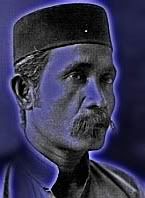11. How to...ranggöh
In this age of plenty when the dining table groans under the weight of akök and nekbak it is often difficult to say when you’ve had enough, but ranggöh is the word that draws the dividing line between the sated and the se’eh.
It is hard to hear the word ranggöh without hearing also the sound of goats lopping off the top of your potted tomato plant. “Ha, sudöh, abih döh kambing ranggöoh pohong mung, Mek!”* is bad news indeed for the green-fingered housewife; but when a mother says, “Hör, gi gök ranggoh lagi akök tu bbanyok sikik!”** it’s sarcasm writ large on a billboard, directed at someone who’s already too busy retching to appreciate its sharp edge. Time then for the Woodward’s Peppermint Cure or the minyök Cak Kapök belly rub.
But to earn the description ranggöh for your eating activity you don’t have to reach the level of se’eh — bloated — because ranggöh is often used to stirke a note of disapproval of one who’s tasted the forbidden fruit (see goat, above).
The companion words to ranggöh are bahang and pölök, each, in its own way, an ambiguous word in social etiquette. A person who declines a seat at the dining table because, on his way home from work, he’d bahang röjök has chosen a crude word to define an innocent act. Now bahang is no mere slurp, it is to attack with relish a pile or morsel, eyes fixed lovingly on the food. Bahang is both a gourmet and a gourmand word, but it’s pölök that really separates the cheekier nosher from the boys. To pölök is to stuff your face with two curry puffs while half a chicken drumstick is still dangling from one corner of the mouth. The mobile phone may ring while this business is undergoing its full course, producing an opening telephonic message that goes: “Hollow, splutter-splutter, pfft, puff...”.
Pölök is an intrinsically harmless act under controlled conditions where the rules are observed. Never, for instance, pölök anything bigger than your head; but bahang and its cousin tibang are essentially attacking words, a throwback to the days when food was killed before it was laid out on the plate, without benefit of a chilling-out period in the fridge. So, ”Aku tibang ayang sekor takdi” could mean both “I have just devoured a whole chicken” or “I have just killed one for the pot”. In Ramadhan, never bahang belong bang, before the muezzin makes his call, or you'll be caught out as a non-faster.
Of the lot, only ranggöh can be soft and hard for while you can eat plate after plate of laksang orderly and quietly in deference to etiquette, you can still draw an observation that’s no feather in your hat: Bukang makang tu, ranggoh!” (“That’s gorging, not eating!”) which is a signal for you to withdraw to the corner for a burp.
-------------------------------------
* ”Oh dear, the goat’s just devoured your plant in the pot!”
** “Go on then, stuff yourself some more with that akök”

